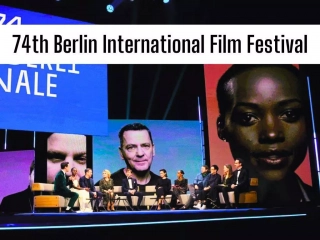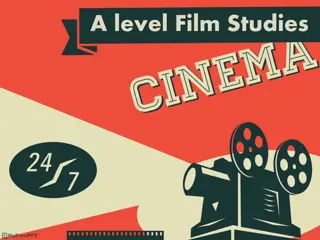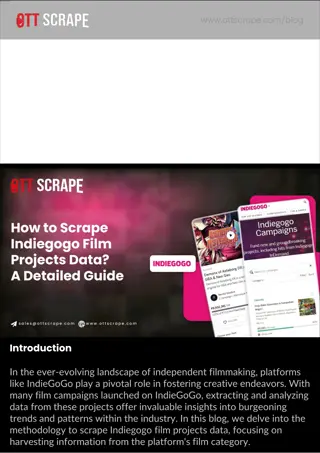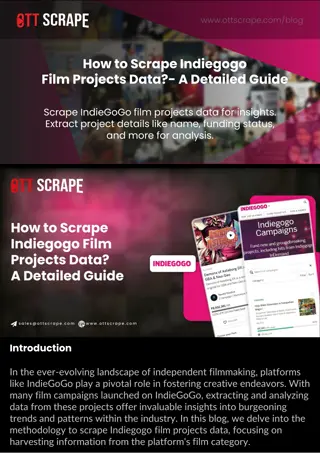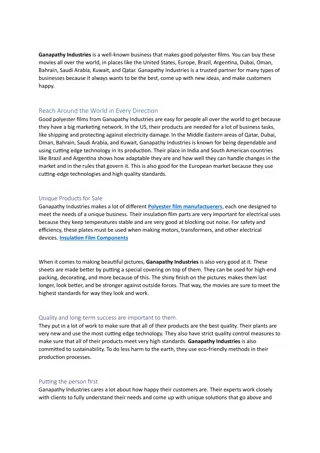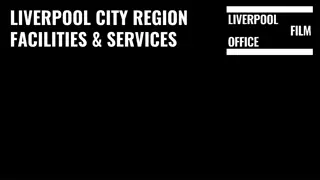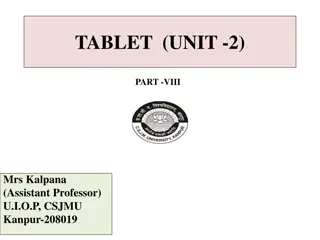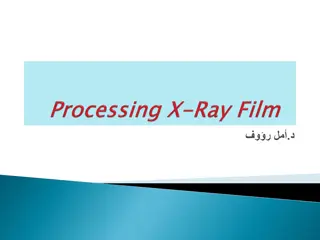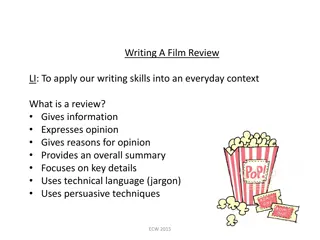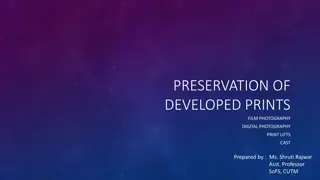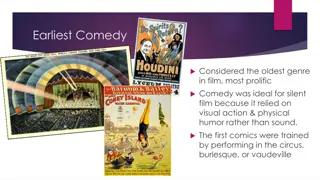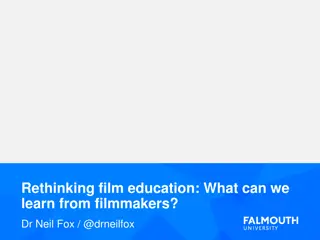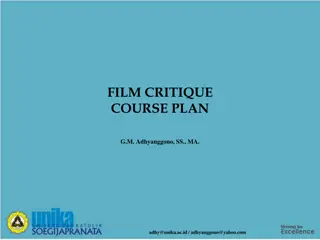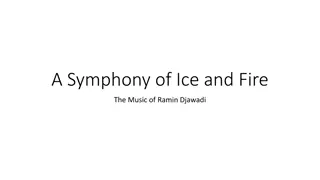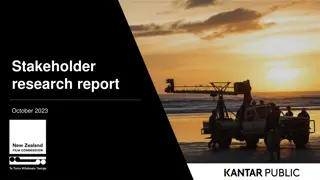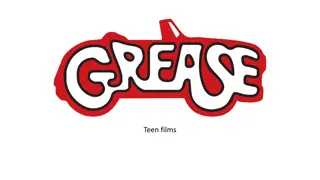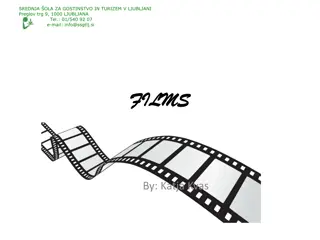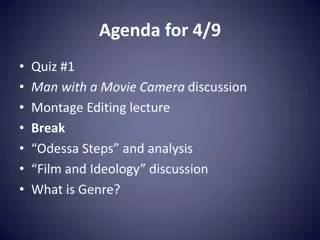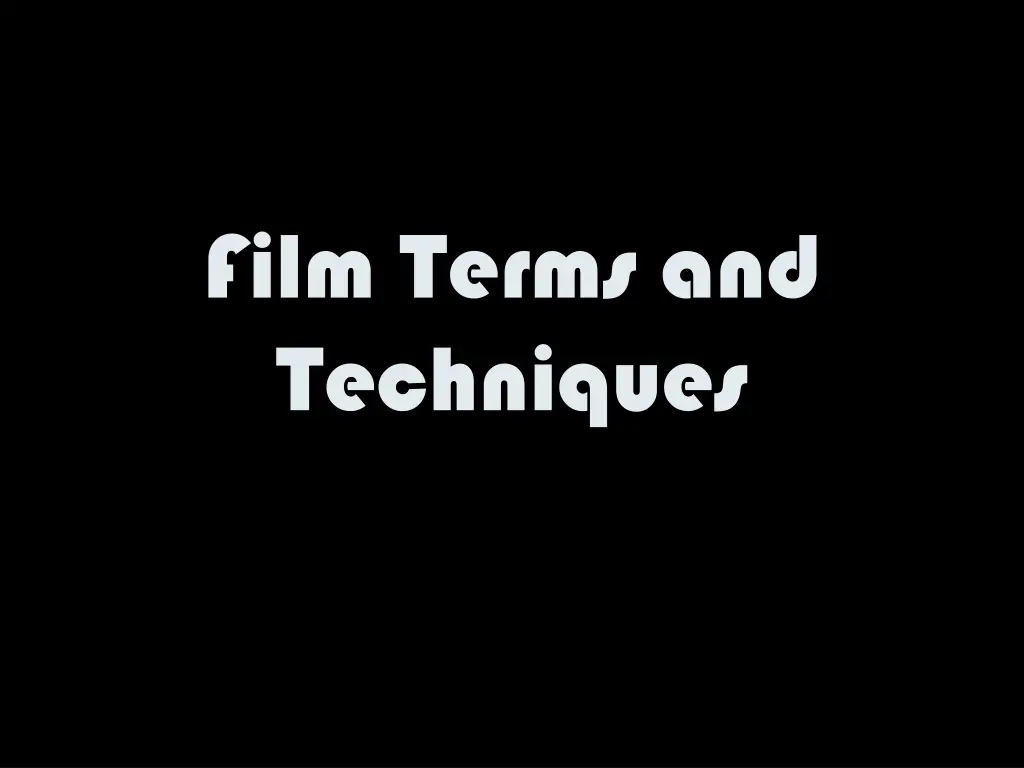
Understanding Film: Terms and Techniques
Explore the different types of films, pre-production essentials like film treatments and storyboards, basic building blocks of film structure, and the significance of mise-en-scene in creating impactful cinematic experiences.
Download Presentation

Please find below an Image/Link to download the presentation.
The content on the website is provided AS IS for your information and personal use only. It may not be sold, licensed, or shared on other websites without obtaining consent from the author. If you encounter any issues during the download, it is possible that the publisher has removed the file from their server.
You are allowed to download the files provided on this website for personal or commercial use, subject to the condition that they are used lawfully. All files are the property of their respective owners.
The content on the website is provided AS IS for your information and personal use only. It may not be sold, licensed, or shared on other websites without obtaining consent from the author.
E N D
Presentation Transcript
Film Terms and Techniques
TYPES OF FILM Narrative: tells a story using characters, setting and plot (most mainstream movies) Non-fiction: documentary style; records real events (March of the Penguins, Bowling for Columbine) Avant-garde: experiments with art and moving image techniques to express a filmmaker s unique way of viewing a subject Example: Andy Warhol s Empire 8 hours of a single, continuous shot of the Empire State Building http://www.youtube.com/watch?v=ZqDHuaVFlyw
PRE-PRODUCTION Film Treatment: The "summary" of the events that take place in the film, made before the script in order to flesh out plot; usually about 10 pages long Script: The complete transcript of dialogue, events, and a basic, idea of the visual style and camera shots; usually about 120 pages long (one page = one minute) Storyboard: a visual overview of the script; shows a drawing of each shot along with camera, sound and editing directions Once completed, the boards play a key role throughout pre-production,mapping out every frame that I intend to shoot. Visually presenting the what, where, why, who, when, etc. of every frame. This gives us a starting point for discussions. As we break down each frame, department by department, they help clarify everyone's responsibilities, needs and expectations. The boards often spur discussions that raise important questions. Many times the answers to these questions are crucial to a successful shoot. Once we finish pre-production and start shooting, mini storyboard sides are distributed to the crew at the beginning of each day. Many of us refer back to them countless times on any given day. Zack Snyder, director of Watchmen
BASIC BUILDING BLOCKS Frame: the basic unit of film structure; ONE scene recorded on ONE piece of film by ONE camera in ONE take (remember 1:1:1:1) Shot: a number of frames put together to show a single event, all from the same angle/position Scene: a cohesive action taking place across a series of shots Sequence: a series of scenes A series of frames makes up a shot of a couple dancing
MISE-EN-SCENE Mise-en-scene ( meez in sen ): roughly translates to put into the scene ; includes everything that appears before the camera and refers to anything that is part of the cinematic process on the set, as opposed to during editing Setting, Lighting, Costume, Space and Acting Effect: conveys visual information to contribute to tone and mood In this shot from 2001: A Space Odyssey (1969) the futuristic furniture and reduced color of the costumes stress the sterility and impersonality of the space station environment and its inhabitants. Bright lighting with no shadows adds to the sterility, while the placement of the actors in the foreground with the background seemingly stretching far into the distance suggests the infinite stretch of outer space
Mise-en-scene: Setting Setting: Creates a sense of place and mood; may be fabricated in studio or shot on location Sophia Coppola s elaborate studio recreation of Versailles in Marie Antoinette (2006) The Lord of the Rings trilogy was shot on location in New Zealand
Mise-en-scene: Lighting Three Point Lighting: light comes from three different directions (key, fill and backlight), providing even illumination, sense of depth and some shadows; the most common type of lighting Effect: authenticity, reality The characters in Breakfast at Tiffany s (1961) are illuminated, but the shadows behind them give the scene depth
Mise-en-scene: Lighting High-Key Lighting: an increase in the intensity of the fill lights, creating a very bright, soft effect with very few shadows; used commonly in musicals, comedies and Classics Effect: openness, innocence, sterility High-key lighting was used in the Wizard of Oz (1939), along with many other musicals and comedies of the Classic era. Its use in this film adds to the fantasy world of Oz
Mise-en-scene: Lighting Low-Key Lighting: a reduction in the intensity of the fill lights, creating stark contrasts between dark and light and flooding a scene with shadows; used often in Film Noir or gang/mob themed films Effect: mystery, danger Low-key lighting is utilized in The Godfather (1972) in this scene lit predominantly by the light coming in through the blinds and the desk lamp
Mise-en-scene: Lighting Side lighting: lighting a subject from one side Effect: creates a subject who appears dangerous or evil, morally ambiguous or with a split personality Vincent D'Onofrio invoking the stare as Leonard "Gomer Pyle" Lawrence in 1987's Full Metal Jacket. Private Pile s instability is accentuated nicely in this side-lit shot from Full Metal Jacket (1987)
Mise-en-scene: Lighting Back-lighting: lighting the subject from behind, or placing a darker subject/object against a brighter background Effect: creates a silhouette or halo around the subject The bright flames create a backlit subject whose frontal features are obscured useful for hiding the identity of this masked villain in V for Vendetta (2006)
Mise-en-scene: Costume Make-up or wardrobe choices used to convey a character s personality or status; also important in establishing the historical and biographical features of a particular era or figure Salma Hayek s costume of authentic Mexican garb and make-up (fake uni-brow) help her become the real-life Mexican artist, Frida Kahlo in the movie Frida
Mise-en-scene: Space Deep Focus: a shot that utilizes a large depth of field, where the foreground, middle ground and background are all clear and in focus Effect: emphasizes the distance between objects and/or characters Orson Welles and his cinematographer, Gregg Tollan, were responsible for popularizing Deep Focus in Citizen Kane (1941) as seen in this shot---notice that the eye can clearly see the woman in the foreground, the chair in the middle ground and the boy out the window in the back ground
Mise-en-scene: Space Shallow Focus: a shot that utilizes a small depth of field, in which only one plane (fore, middle or background) is in focus Effects: emphasizes one part of a scene Shallow focus is used to emphasize Sandra Bullock s character in the middle ground, blurring the guests in the background and Ramone in the foreground
Mise-en-scene: Space Off-screen space: elements of the film world that are not physically present in the frame, but which are suggested by a character s response to something offscreen http://collegefilmandmediastudies.com/mise- en-scene-2/ In this clip, the viewer becomes aware that Ricky is filming Jane, even though we never see him on screen
Mise-en-scene: Space Frontality: characters directly face the camera; otherwise know as, breaking the 4th wall Effect: personal connection with character http://collegefilmandmediastudies.com/mise- en-scene-2/ In this scene, Ferris speaks directly to the audience, informing the viewers of his thoughts and letting them in on his mischief
Mise-en-Scene: Space Blocking: the meaningful arrangement of subjects and objects Effect: shows relationship between characters The blocking in this scene from The Godfather (1972) shows the supremacy of the Godfather and the submission of his subjects
Mise-en-scene: Acting Method: the actor attempts to become one with the character Stylized: actors utilize conspicuous tactics such as overacting or caricature A method performance by Daniel Day Lewis in There Will Be Blood (2009) A stylized performance by Jim Carrey in Dumb and Dumber (1994)
CAMERA SHOTS Wide (long): a shot taken at a considerable distance from the subject Effect: show subjects in their environment, offer lots of non-specific detail Medium: a shot framing a subject at a medium range, usually from the waist up Effect: good for showing body language and used often in dialogue shots
Camera Shots: Distance Close-up: a shot showing a detail only (face only, for example) Effect: creates intimacy between audience and character Extreme Close-up: a detail of a close up (just the eyes or nose, for example) Effect: often used to create suspense; calls attention to subtle reactions
Camera Shots: Distance Establishing: a shot that sets the time and place of action or concepts Effect: usually used to start a sequence so as to orient the viewer http://www.youtube.com/watch?v=Axt0nETgEXo In this compilation of establishing shots, think about what time, place, relationships or concepts are being set
Camera Shots: Distance Over-the-Shoulder: a shot of a subject taken from over the shoulder of another person whom you see in the shot Effect: allows the viewer to feel more intimately tied to the characters and the conversation *OTS shots also allow for easier dubbing of dialogue A tearful but happy reunion between Rapunzel and her mother in Tangled (2010) Ben Stiller having an uncomfortable conversation with his father-in-law in Meet the Parents (2000)
Camera Shot: Duration Long take: a long sequence made without stopping the camera Effect: a relaxed, slow pace *long takes are difficult for directors because any error during the filming will result in re-starting the scene from the beginning http://www.youtube.com/watch?v=RaN4R6KRSY0 Compare the long take from Touch of Evil (1958) and The Player (1992). What is similar about Welles s and Altman s use of the long take? Try to identify places where cuts may seem natural http://www.youtube.com/watch?v=BEk-QGNQ3OM
Camera Shot: Duration Short take: a very quick sequence; a scene of short takes will have a lot of cuts Effect: an urgent, fast pace; used most often in action sequences and mainstream Hollywood films http://www.youtube.com/watch?v=t8J0Ib8Dt 9M Try to count the number of cuts in this action scene from Fast Five
Camera Shot: Angles Low: the camera looks up at what is being filmed Effect: makes subject appear larger or more powerful https://www.youtube.com/watch?v=RLu0Sg6VOWQ High: the camera looks down at what is being filmed Effect: makes subject appear smaller, weaker, insignificant, helpless or lost in his/her surroundings Bilgo Baggins seems even smaller and more insignificant in this high angle shot in the lush surroundings of Rivendell http://www.davidbordwell.net/blog/wp-content/uploads/Hobbit-Bilbo-in-Rivendell-entranced-high-angle-small.jpg
Camera Shot: Angles Bird s Eye View: the camera looks directly down on the subject from above Effect: familiar objects seem strange/unrecognizable; puts the audience in a godlike position; people are made to look insignificant, ant-like, part of a wider scheme of things http://www.youtube.com/watch?v=jErFoxRnvto The opening of The Shining (1980) contains many great film techniques. Bird s Eye view is one of them, allowing the viewer not only to follow the car s path, but also to assess the empty, isolating landscape
Camera Shot: Angles Worm s Eye: a shot of a subject from far below Effect: subject looks tall, strong, powerful, significant http://www.movie-censorship.com/www/SBs/4440/011.jpg A view of Jason Stratham that only a worm, or a worm s eye view angle, would see
Camera Shot: Angles Dutch Angle: a shot tilted off to one side, composed with vertical lines at an angle to the side of the frame Effect: imbalance, transition, instability http://theenvelope.latimes.com/awards/emmys/la-en-lightsdoubt- 2008dec03,0,510669.story http://media.trb.com/media/alternatethumbnails/story/2008-12/43640240-02155407.jpg This interesting article explains how Dutch angles help signal unease in Doubt (2008)
Camera Shot: Angles Neutral: the camera is level with subject s eye/gaze, offering the clearest view of an object Effect: limited dramatic effect (neutral angle is the norm); audience feels comfortable with characters http://hussainjqegs.files.wordpress.com/2013/02/eyelevelshot.jpg A moment to get cozy with Vivian and Edward in Pretty Woman (1990)
CAMERA MOVEMENT Pan: camera rotates horizontally from side to side on top of a tripod, which remains stationary (think panorama ) Effect: mimics the movement of the head or eyes from side to side http://www.youtube.com/watch?v=BahpdL8cxGc Tilt: camera pivots vertically, up or down Effect: helpful in showing the immensity of buildings, trees or even people http://footage.shutterstock.com/clip-1070983-stock-footage-tilt- up-to-a-tall-skyscraper-building.html
CAMERA MOVEMENT Tracking: camera movement toward or away from the subject; a camera that follows a subject/object that is itself moving http://www.raindance.org/site/index.php?id=476,8724,0,0,1,0 Boom/Crane: camera moves through space at a vantage point not possible from the ground; this movement takes its name from the apparatus boom or crane on which the camera is mounted http://www.youtube.com/watch?v=3Aqk4I4zmG8 An early (and famous) crane shot from High Noon (1952) Filmmakers on a crane
SOUND Diegetic: sound that is natural to the scene Non-Diegetic: sound that is not natural or is added to the scene http://www.youtube.com/watch?v=juVb1SDHW rk A tutorial on understanding the diegetic elements of film
EDITING: Basic Cuts Cut: joining together of two different shots Reverse Cut: a cut to the opposite angle Point of View (POV): a cut to what the character is seeing Reaction: a cut to a character reacting Insert/Cutaway: a cut to a small but significant detail of a scene (often to the writing that a character is reading or an object that a character is contemplating)
EDITING: More Complex Cuts Sound Cut: a cut motivated by sound Eyeline Match: a cut that matches the line of vision between characters eyes Framing Match: a cut that matches the space/blocking of characters Action Match: a cut that matches the action/movement of the character to the action/movement of the character in the next shot Smash Cut: an unexpected and very quick cut
EDITING: More Complex Cuts Freeze Frame: Slow Motion: Speed Up: Reverse Motion: Flashback: Flashforward: Cut-away:
EDITS CONT. Eye-line Match: cutting to an object, then to a subject to indicate the subject is looking at the object Point-of-View: camera is positioned to view the objects or events through the eyes of the main subject Ex. Lord of War intro following the bullet from production to the shot from the gun http://www.youtube.com/watch?v=VHn1zogeyO4 Freeze Frame: the image is printed or held in a frame to give the illusion of a photograph
Kill Bill Film Terms & Techniques http://www.youtube.com/watch?v=UFCb-iYTSg0 In the clip from Kill Bill that we will watch, list ANY film techniques or examples of terms that we have gone over in the past three days. Consider shots (both lengths and types of shots), sounds, editing , lighting, camera angles, etc. Then, choose three of the techniques you ve listed and explain why you think Tarantino might have chosen to film the scene using that technique.

